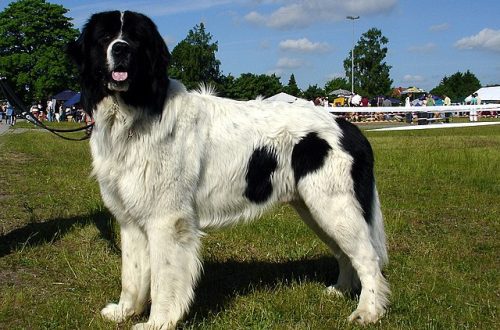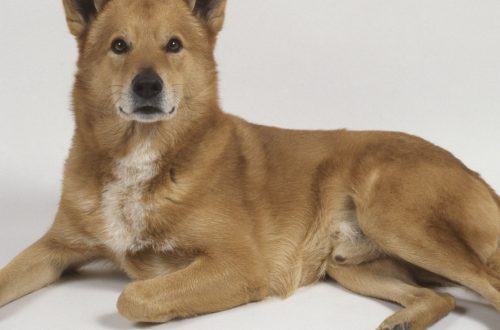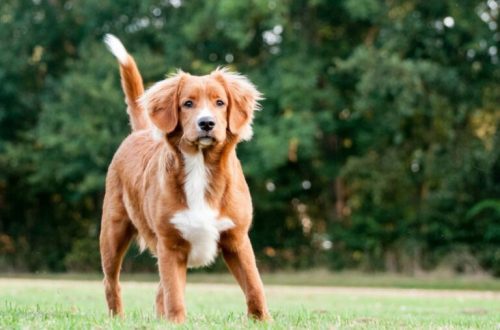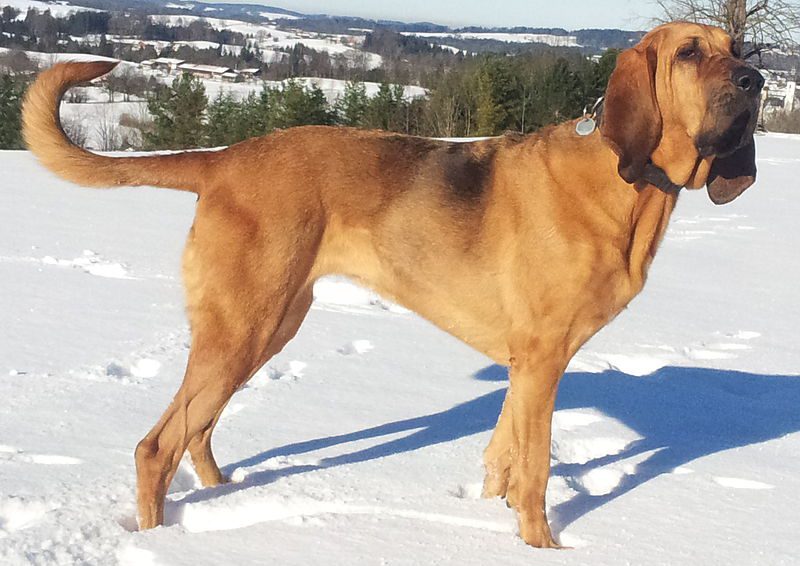
Bloodhound
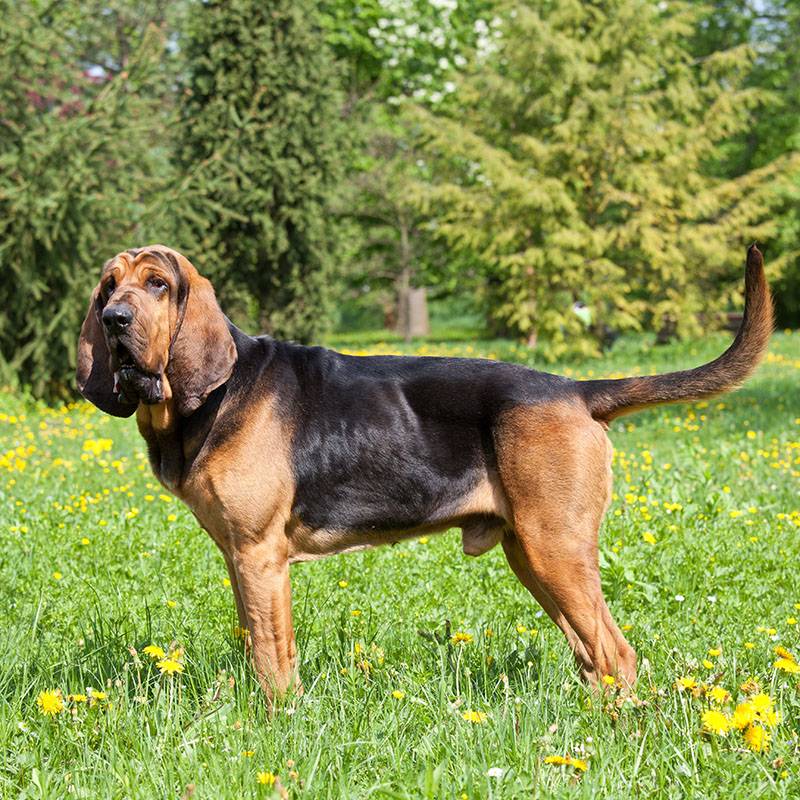
The Bloodhound is a hunting dog. Can be a great friend for the whole family. Completely non-aggressive towards people.
| Country of origin | Belgium |
| The size | Large |
| Growth | 58-72 cm |
| Weight | 40-54 kg |
| Age | 7-10 years old |
| FCI breed group | Beagles and related |
Contents
- Bloodhound Pros and Cons
- Bloodhound Facts
- History of the Bloodhound breed
- Description of Bloodhounds
- The nature of bloodhounds
- Training and education
- Keeping and caring for Bloodhounds
- Bloodhound Nutrition Tips
- Health and typical diseases of Bloodhounds
- Photo of Bloodhounds
- Who is this breed for?
- Famous Bloodhound dogs
- How to choose the right puppy
- Photos of bloodhound puppies
- Owner experience
- Bloodhound prices
- Bloodhound – Video
Bloodhound Pros and Cons
| PROS calm; Friendly with all people; Excellent hunters; Get along well with children; The molt passes almost imperceptibly. | CONS Large size; Need a persistent owner; Poorly tolerate heat and stuffiness; They cannot live in an aviary in winter. |
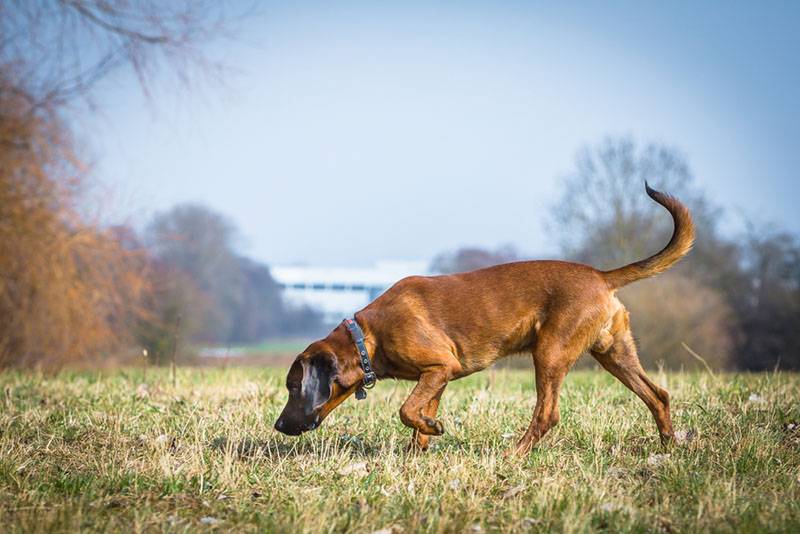
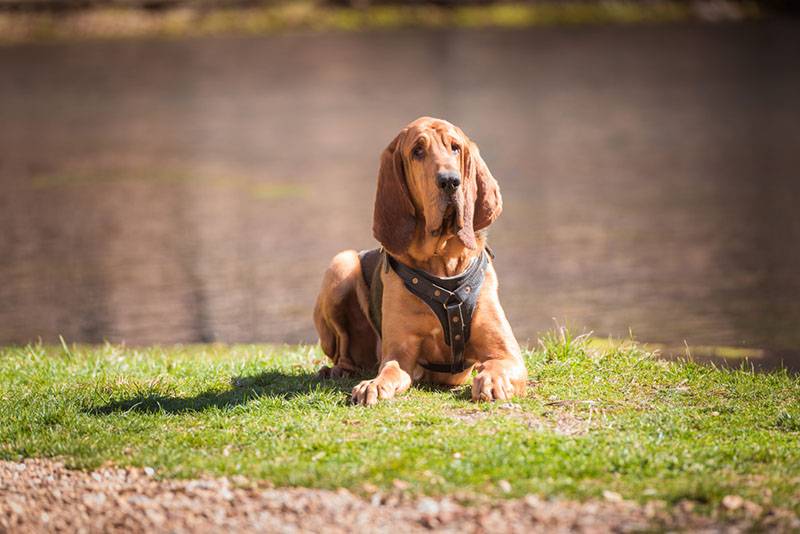
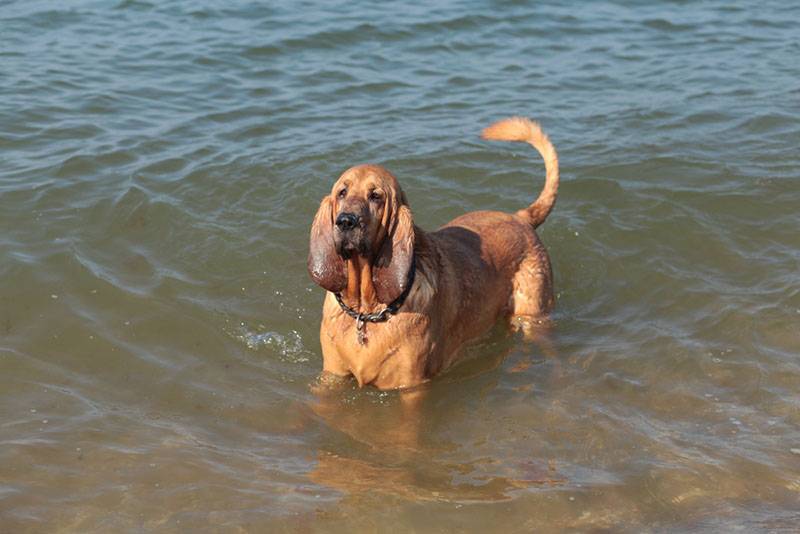
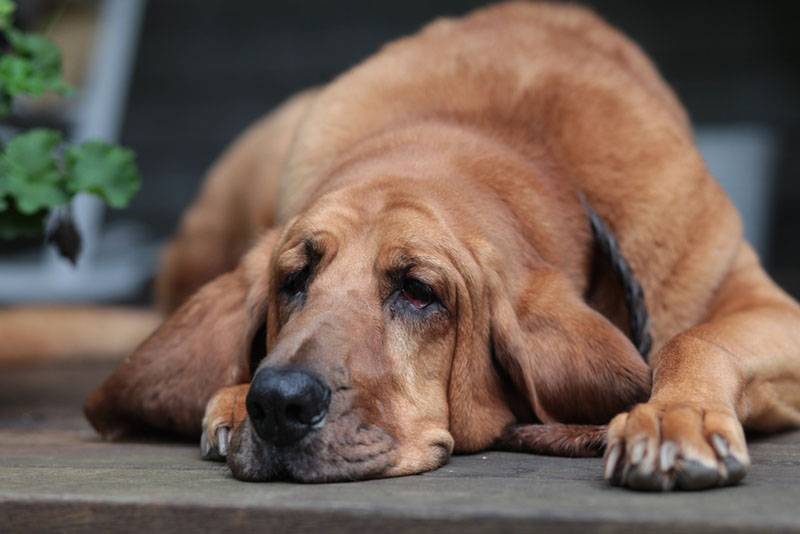
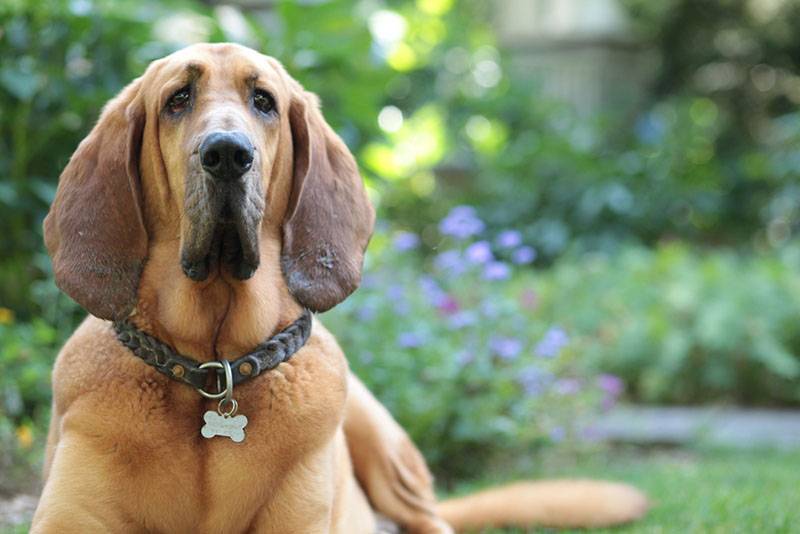
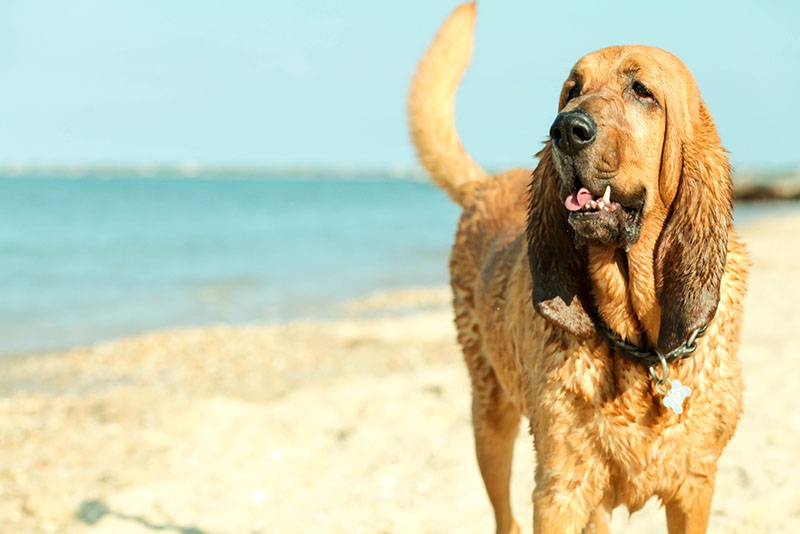
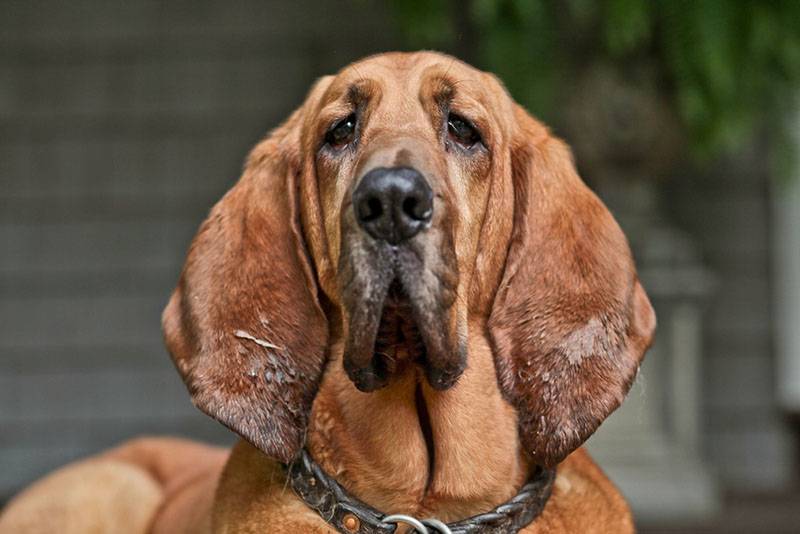
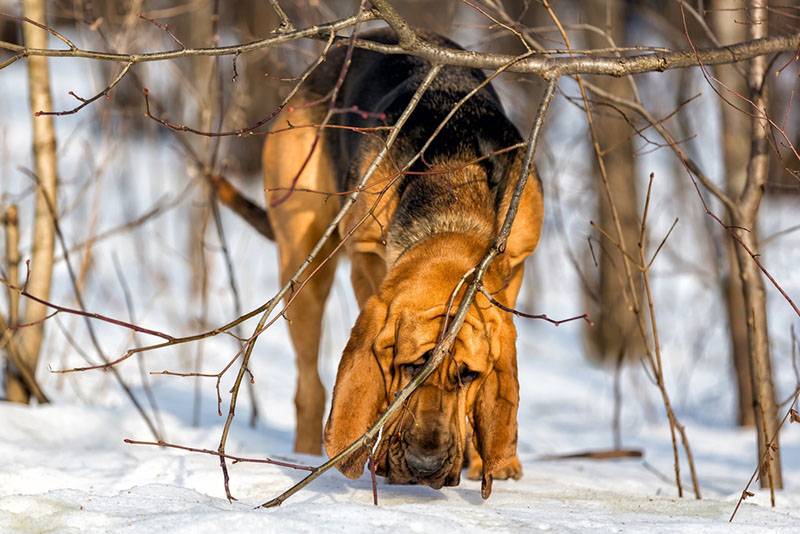
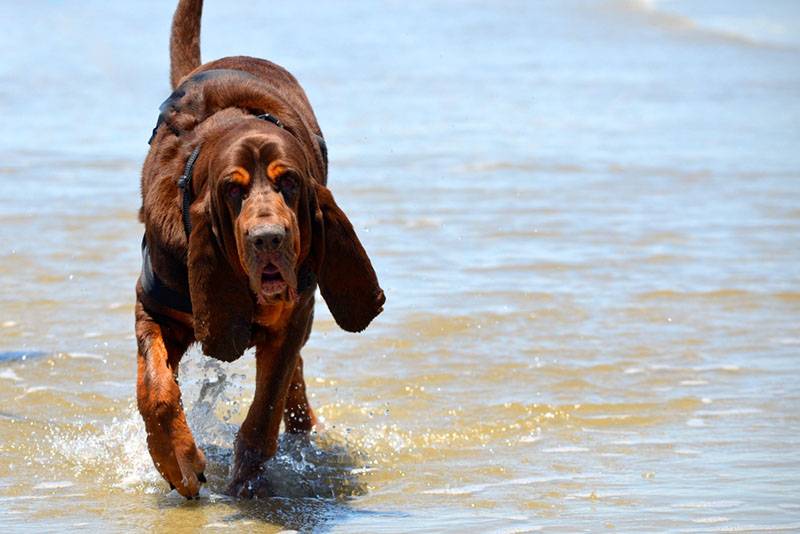
Bloodhound Facts
- The skin of an animal falling over his eyes helps him to concentrate on the smell. The dog literally does not see anything around when he takes the trail. Bloodhounds are the perfect trackers. They can smell the trail left by the prey a few days ago.
- The facial expression of these animals is special. Changing the dog’s mood does not affect him at all. The look of the Bloodhound closely resembles that of the Basset Hound. He looks very meaningful and at the same time slightly distant.
- This breed is very fond of not only physical exercise, but also intellectual activity. Give your dog mental tasks regularly. Bloodhounds enjoy solving puzzles and finding hidden things.
- When eating, it is better to remove the long ears of the animal up. This will help keep them clean as they won’t fall off the plate.
- The cartoon character – a dog from “The Bremen Town Musicians” (1969) directed by Inessa Kovalevskaya – very much resembles a Bloodhound in its appearance.
History of the Bloodhound breed
There is a legend that these dogs were bred in 1000 AD. in the monastery. It is believed that one of the monks, even after taking the tonsure, remained an avid hunter and was actively engaged in breeding hounds. The animals were named in honor of this clergyman – the hounds of St. Hubert. After his death, the monk was canonized and was considered the patron saint of all hunters. Every year, until the beginning of the 18th century, the monastery supplied such pets to the king’s palace.
They were one of the largest hounds and were primarily used to hunt a large forest animal – a wild boar. They were very hardworking and hardy. They could chase prey for a very long time and had a brilliant sense of smell, allowing them to find it on the trail.
Initially, only black individuals were found, later tan ones appeared.
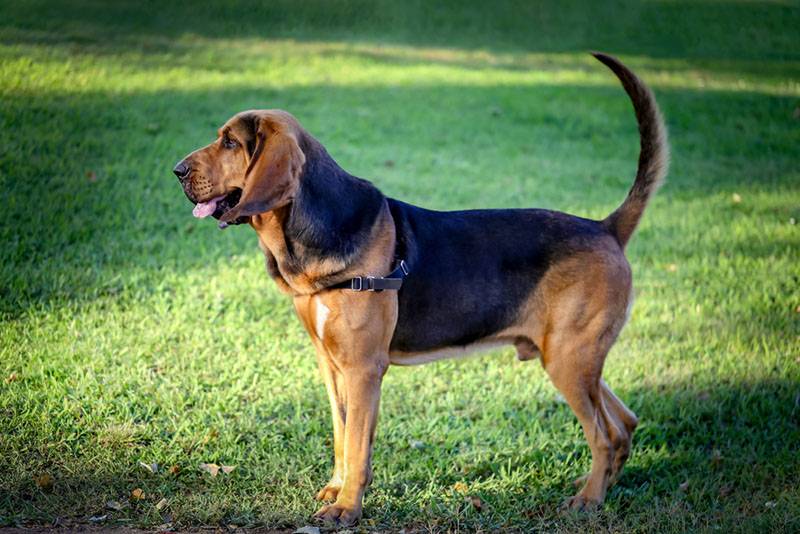
L.P. Saboneev, a Russian zoologist and naturalist, author of a work on hunting dogs, wrote in his book that the hounds of St. Hubert played a significant role in the formation of all breeds of smooth-haired hounds in Central Europe and England. The bulk of the long-eared dogs came from them – beagles , harriers . At the same time, he clearly separated the two separate breeds of “Hounds of St. Hubert” and “Bloodhounds”, since he was sure that they were significantly different from each other. Bloodhound is more like a mastiff, his head is flattened on the sides. The Hound of St. Hubert is the immediate ancestor of the Bloodhound.
Another group of scientists are sure that the hounds of St. Hubert and bloodhounds are one and the same.
At home – in Belgium – the breed became a dog that was very fond of the crowned persons. It is believed that they were brought here in the 11th century by William the Conqueror.
There are several versions of the origin of the name of the breed. According to one of the assumptions, the name comes from the English word “blood”, which means “blood” and is associated with the excellent ability of dogs to follow the trail of a wounded beast. Another version – the dogs were obtained through exceptional purebred breeding.
In the 18th century, Bloodhounds came to America. Local residents were not interested in these dogs as game hunters, they used them in a different way – to catch runaway slaves and convicts.
The Europeans made service dogs out of them. So, in 1616, a law was even issued in England, according to which every sixth guard post should have its own Bloodhound, capable of following a “hot” trail if necessary. The English were obliged to unconditionally open the door of their dwelling if the dog led the guards to their house.
The breed came to the Russian Empire during the reign of Peter the Great. But after the death of the reformer, she lost her popularity. Re-breeding of these animals in our country began to be engaged only in the 1980s.
The first standard was created in 1896. The modern standard differs from the first mainly in the name of the colors of the dogs. The final standard was approved in the early 2000s.
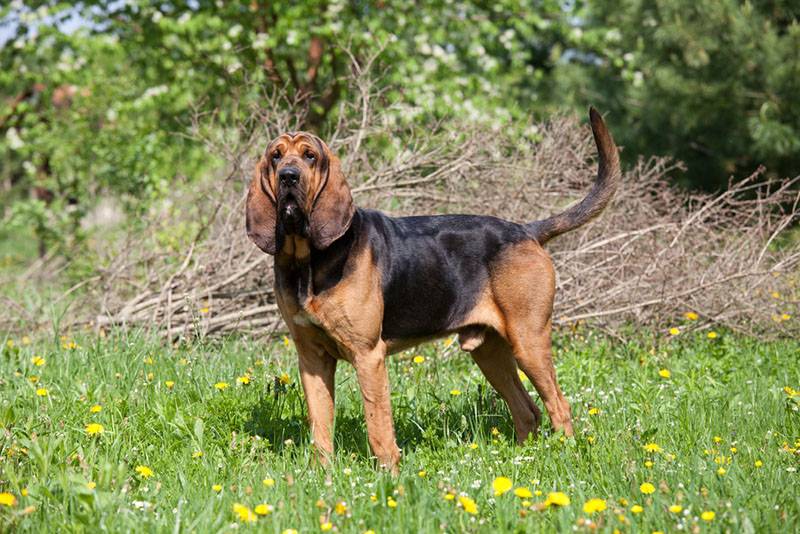
Description of Bloodhounds
Bloodhounds are large pets. Their distinctive feature is the skin with abundant folds. They are both on the body of the animal and on the muzzle. This dog is considered one of the largest hounds. She has a strong skeleton and well-developed muscles.
The coat is short, coarse. Well protects the dog from the rain. Colors, according to the standard, can be several.
Head
It is large in representatives of the breed, but at the same time it is in complete harmony with the body. The bone structure of the skull can be clearly seen even through the skin of the animal. If you look behind the Bloodhound from the side, then his head will resemble a square in shape. On the cheekbones and on the forehead, the skin folds into abundant folds. This is especially pronounced in males, females usually have much less wrinkles. When the dog leans down, the folds become very distinct.
The occipital protuberance strikes very well. The stop is almost invisible.
The nose can be either black or brown (if the dog has a lighter color). The lobe is wide, large. Her nostrils are open, well developed. The bridge of the nose, according to the standard, can be either straight or slightly convex (the so-called “ram’s nose”).
The lips are pendulous. Very soft. The upper lip completely covers the lower jaw of the Bloodhound. The wings are very well developed, especially in males. The pigmentation of the lips is bright – black or brown (always corresponds to the color of the dog’s nose).
The bite of the Bloodhound should be in a scissor or level bite. A complete dentition consists of 42 teeth.
Eyes
The color of the iris is preferably dark brown, brown. A light iris can be in animals with a lighter color – in those that do not have black spots.
Eye size is medium. The shape is oval. The iris should be visible. The lower eyelid is always pendulous.
The expression of the eyes of the breed is special – a little sad, always good-natured.
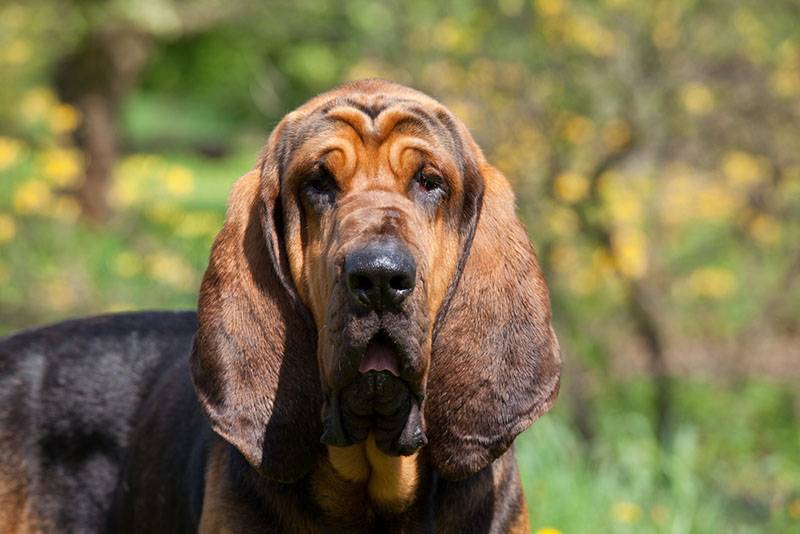
Ears
They look thin and elastic in the dog. Long. If you pull them on, they will reach the nose or even block it. Their coat is short and velvety.
Neck
It should be long enough for the Bloodhound so that the dog can tilt it to the ground to take the trail.
Frame
The body of the dog is powerful, muscular, looks slightly elongated. The line of the bottom and top are almost parallel to each other.
The withers are weakly expressed. The back is straight. The croup cannot be sloping. The chest is powerful, well let down. The ribs don’t look barrel-shaped, but they aren’t flat either. Moderately curved. The abdomen is slightly tucked up.
Tail
It is quite long in the Bloodhound. His posture is high. The tail is thickened at the base, becoming thinner towards the end. Has the shape of a saber.
When the dog moves, she raises him to the level of the back. In a calm mood – lowered down. Should not bend or twist. The lower part of the Bloodhound’s tail is covered with the so-called “brush” – hair 5 centimeters long.
limbs
The fore and hind legs are parallel to each other when viewed from the front and back. Powerful, strong. The thighs are well developed.
The paws look compact. The fingers are brought together in a “lump”. The pads are strong and thick. The nails are of moderate length. Pigmented in the color of the main color of the animal.
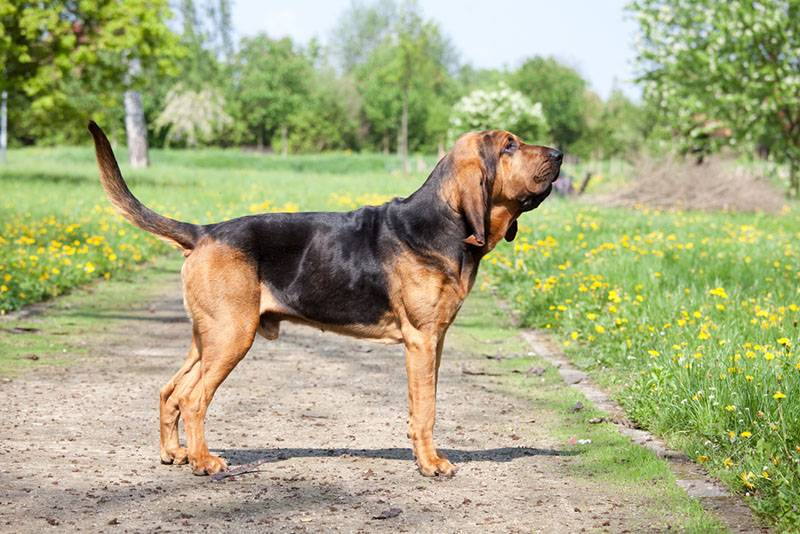
Gait
When the Bloodhound moves in a gait, its step is even and rhythmic. Its movements are much more sweeping than other hound breeds. The hind limbs provide the animal with a strong push. The line of the back in the process of running and walking should remain flat.
The Bloodhound also moves freely and sweepingly when transitioning to a trot. Able not to get tired for a long time.
Wool
It is short and stiff in representatives of the breed. A more delicate coat on the dog’s head.
Bloodhound color
According to the standard, three colors of such dogs are allowed:
- Black and red;
- Brown-red;
- Monochromatic red.
In black-red and brown-red individuals, black often covers the entire back. The stain may form the shape of a cloak or saddlecloth. The cloak covers the back completely, the saddlecloth is a V-shaped spot. Red and brown color is present on the muzzle, legs and around the anus. In individuals with a raincoat color, the red color on the body is much less.
The spots may not have a clear outline and are blurry. Sometimes there are blotches of red or brown on black spots.
Solid-colored dogs come in a variety of shades, from light to darker.
Small white patches on the chest, tail and legs are acceptable but not desirable.
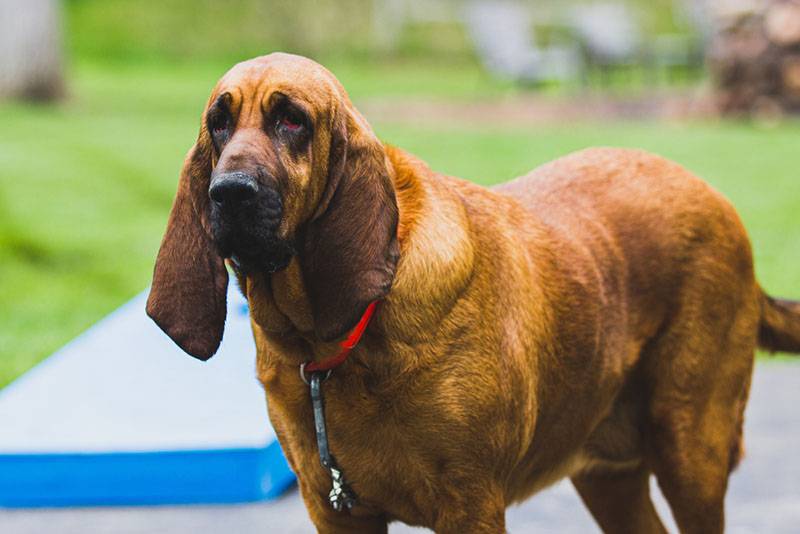
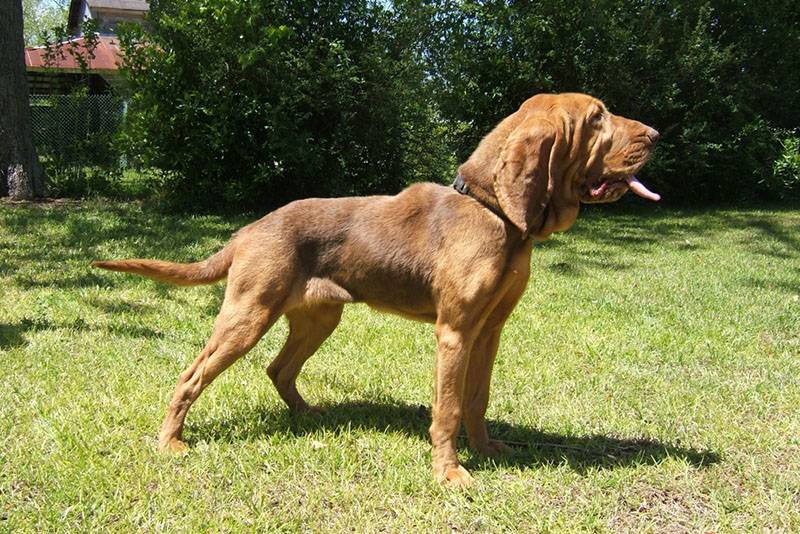
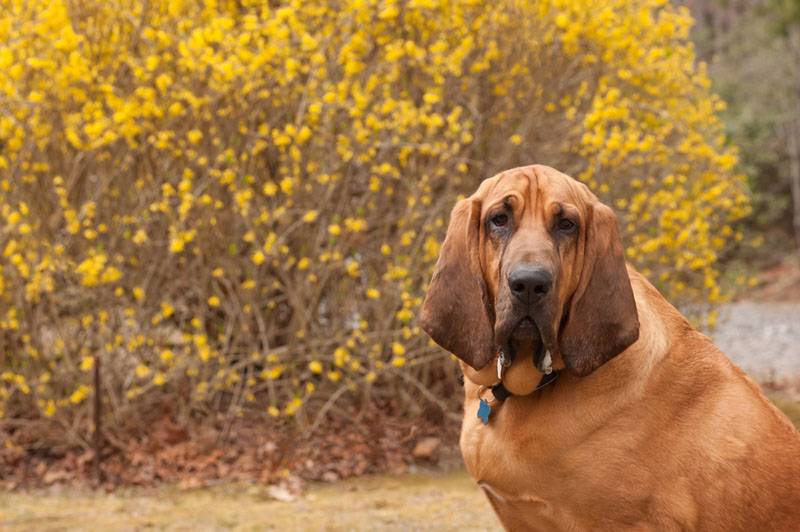
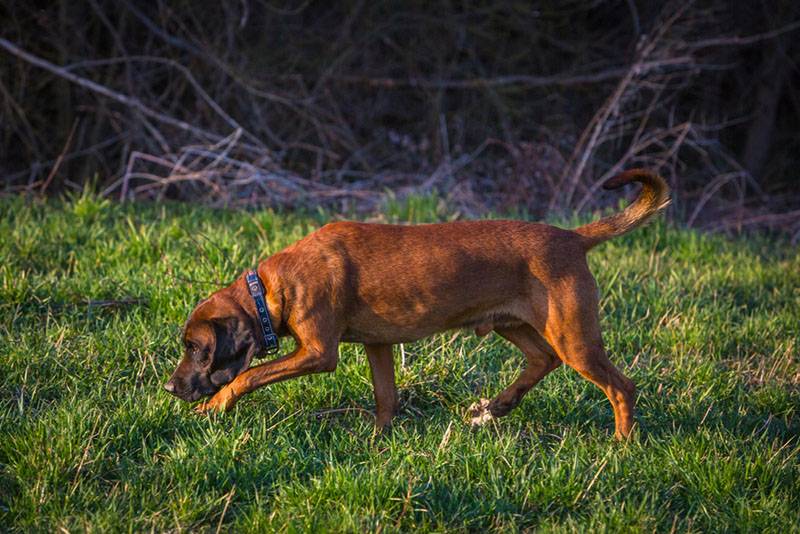
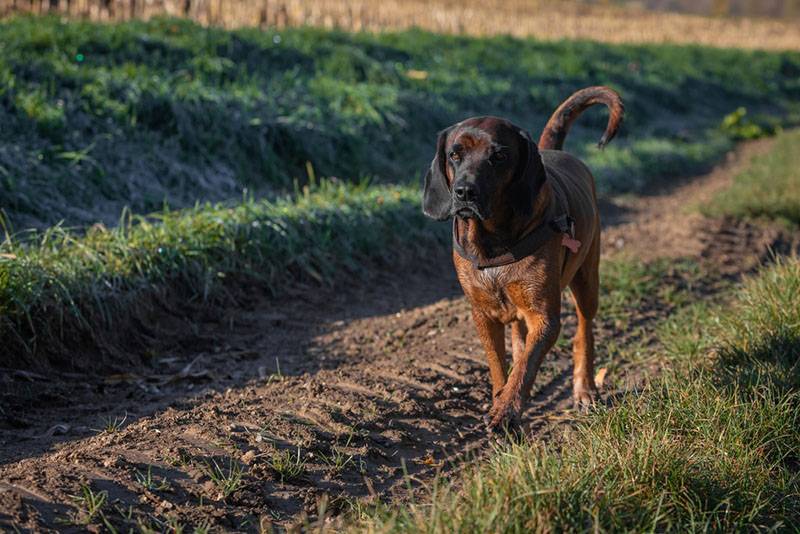

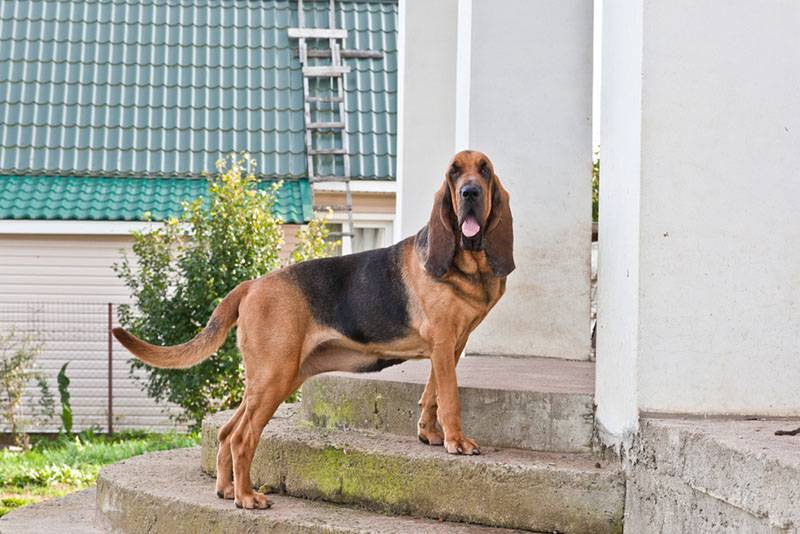
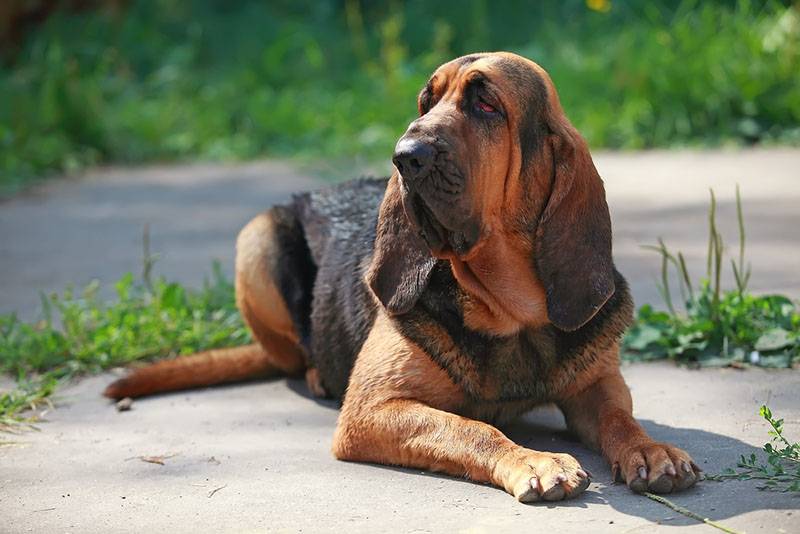
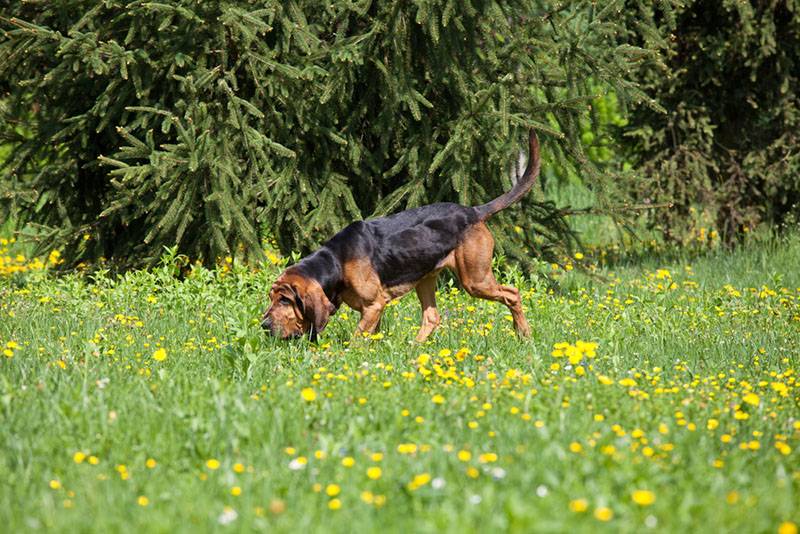
Size and weight
The ideal height for males is 68 cm, for females – 62 cm. Deviations of 4 cm are allowed in either direction.
Males usually weigh 46-54 kg, females are much smaller – 40-48 kg.
The nature of bloodhounds
Hounds, once bred by Saint Hubert, are distinguished by restraint and calmness. Some dogs can even behave phlegmatically. Especially at an older age.
Bloodhounds are very attached to the family in which they live. The owner is devoted with all his heart. Ready to protect all members of their family if they are in danger.
Very affectionate dogs that love to be petted and hugged.
Strangers are treated calmly. A well-bred dog will never be aggressive towards a stranger, of course, if he does not feel that a threat comes from him. Watchdog instincts are poorly developed; these hounds are not recommended as house guards.
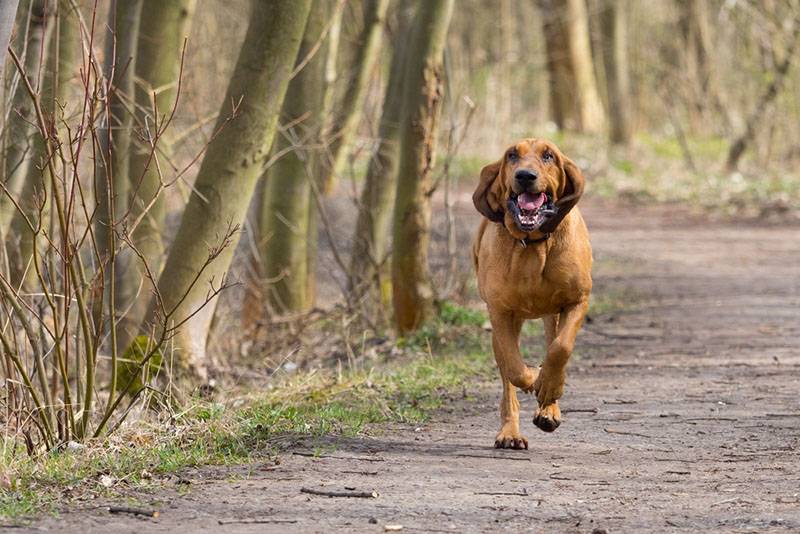
They tend to be shy. In order for the dog to adequately respond to other people, it is necessary to engage in its timely socialization.
This breed loves children very much and treats them extremely patiently. Moreover, they adore not only children who live with them in the same house, but also strangers. However, you should not leave this large pet alone with the child for a long time: it can accidentally push the baby, scratch it, etc.
Dogs are quite sensitive and perfectly understand the mood of the owner. The Bloodhound is always ready to reassure the owner if he is sad, or share his joy with him. They make true friends, loyal and devoted.
These dogs love to bark. Their voice is low and deep. It is necessary to wean an animal from such a bad habit from puppyhood.
They get along with domestic animals only if they grew up with them. For example, they often regard a cat as prey and chase after it. They sometimes behave aggressively with relatives, especially if the pet is of the same sex. Although, in principle, these animals are pack animals, so they can be taught to coexist peacefully in the same house with other dogs quite quickly.
Bloodhounds take a long time to mature. The owner needs to be patient. Remember that a pet can still behave like a puppy until about two years old.
Many representatives of the breed are owners: they really do not like it when their things are taken (toys, leashes, bowls for food). This should be explained to children who live in the same house with such a dog.
Animals need exercise. They will be happy to take a trip out of town, a picnic in nature, a rest by the river.
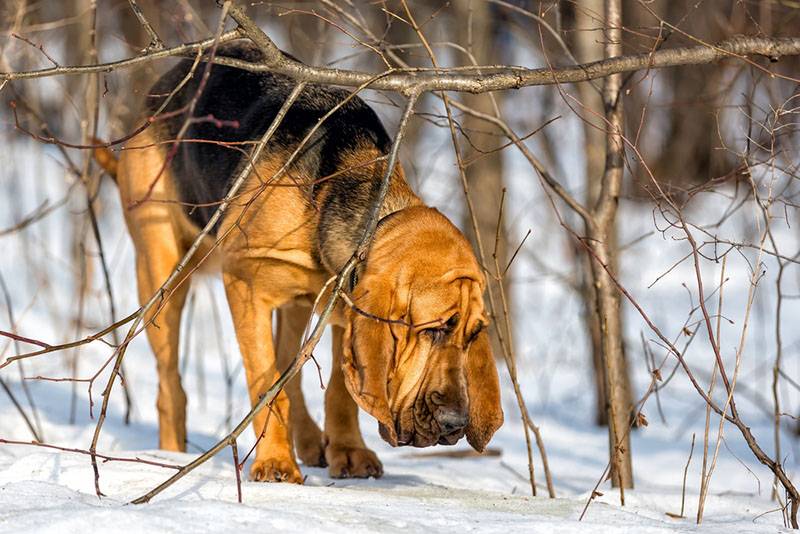
Training and education
Training a dog of any breed is the hard and everyday work of its owner. And it should begin from the first days of the appearance of a puppy in his house.
It is wrong to think that at 2-3 months the baby does not need to be brought up yet. He is able to master elementary skills already at this age. For example, from the first days the puppy should be explained where his sleeping place, dishes, you can start accustoming him to a collar, leash and muzzle.
Nickname training is one of the most important steps in raising a puppy. If the dog learns to respond to his name, it will not be difficult for the owner to attract his attention if necessary. This process is quite simple: call your pet as often as possible, call his name. Try to make the baby realize that they are talking to him. Reward the animal. As soon as it responds and approaches, give it a treat. As a treat, you need to use healthy food, not sausages, sausage, rolls. They are harmful to dogs. It is better to take dry industrial food. It is easy to use and good for your pet.
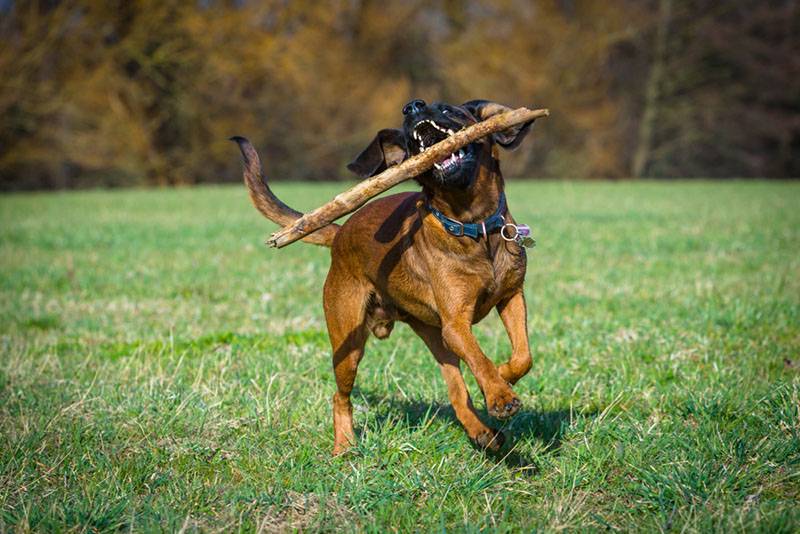
In the process of training, do not yell at the dog. Even if he fails to do something. Be patient. You need to react calmly to failures, usually after 30-35 repetitions of the same action, the dog masters the skill. If this does not happen, try to evaluate yourself: have you built the learning process correctly, maybe the dog simply does not understand what you require from him.
Diversify the learning process. Even the most obedient pet will get tired of boring activities. Alternate different types of training: physical activity can be changed from time to time to intellectual tasks that stimulate mental activity. These include the search for a hidden object, labyrinths with “sweets”, etc.
Bloodhounds are very intelligent dogs. However, in the process of learning, they, like many other hunting breeds, tend to be self-willed. Be persistent: it is necessary to achieve the execution of each given command.
One of the most important commands for a dog of this breed is “Come to me”. Since the dog during the walk can be distracted by someone’s trail or some kind of living creature, he will often have to be called to him. In public places where there are many different animals and other pets, it is better not to let him off the leash at all. The territory of a country house with a high and reliable fence is considered an ideal place for walking.
Teach your dog to walk alongside and not pull on the leash. If such a dog, which weighs about 50 kg, will constantly pull you where he wants, then it is he who walks you, not you.
Bloodhounds are very fond of picking up all kinds of garbage while walking. This habit is very dangerous to health. Wean your dog from it from an early age. Do not walk near landfills and trash cans, call your pet with the “Fu”, “No” command if he tries to take something into his mouth.
If you understand that you can’t cope with training on your own , contact the cynologists.

Keeping and caring for Bloodhounds
Bloodhounds are large dogs. That is why a small apartment for them will not be an ideal home. It is better if they live in a country house or in an aviary with a warm booth. But it is advisable to take the animal from the aviary to the house in winter, since short hair will not warm it in extreme cold.
The breed also tolerates heat with difficulty. In hot weather, try not to take the dog outside for a long time. Give him a rest in the shade with constant access to a bowl of drinking water.
Any hygiene procedures must be taught from puppyhood. As soon as the baby has appeared in the house, he can:
- Comb out wool;
- Cut claws ;
- Brush your teeth, ears.
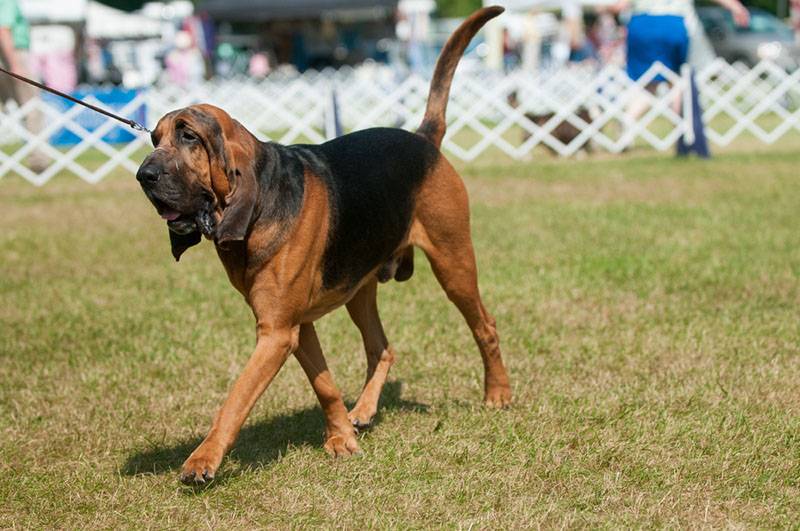
The coat of such dogs does not need special care: it will be enough to comb it out 1-2 times a week with a silicone brush. It is very often undesirable to completely wash the animal: once a month is quite enough. For this procedure, special shampoos for short-haired breeds are used. While swimming, watch the water temperature – it should be 37-39 degrees. Do not allow shampoo to get into eyes, ears, nose. If such a nuisance does occur, rinse the area thoroughly with water.In the summer, when there is no dirt on the street, after walking, the paws can be wiped with a napkin.
In autumn and spring they are washed with warm water. In winter, it is better to use soap for cleaning to wash off chemical reagents from paw pads that are sprinkled on roads in cities from ice. These mixtures can irritate the dog’s skin, causing inflammation. To protect against cold and aggressive substances, special waxes can be used. They are applied immediately before walking and removed immediately upon arrival home.
The nails of pets are cut every 10-14 days. If the dog walks on the pavement, then the claws usually wear down on their own and do not need to be trimmed at all.
Nail clipping is a simple procedure, but if the owner of the puppy has no experience in such matters, you can seek help from a specialist. He will show you how to properly cut off the overgrown part of the claw without injuring the blood vessel passing inside it.
Teeth can be cleaned daily, just like people. The daily procedure will allow you to regularly get rid of plaque. This will help prevent the formation of caries and tartar. For cleaning, you need to buy veterinary toothpastes and brushes for dogs. Brushes should be selected based on the size of the animal’s mouth.
Bloodhounds are among the breeds that drool profusely. Wipe them with pre-prepared rags or napkins. For transporting dogs in a car, special seat covers are purchased that protect the upholstery not only from saliva, but also from wool.
Ears need to be cleaned regularly. Otherwise, inflammation may occur under such long ears. It is better to use veterinary lotions for this. Do not use boric alcohol, peroxide, baby creams and cotton swabs for cleaning.
After eating, the dog’s face should be washed with warm water. Otherwise, pieces of food will remain in the folds.
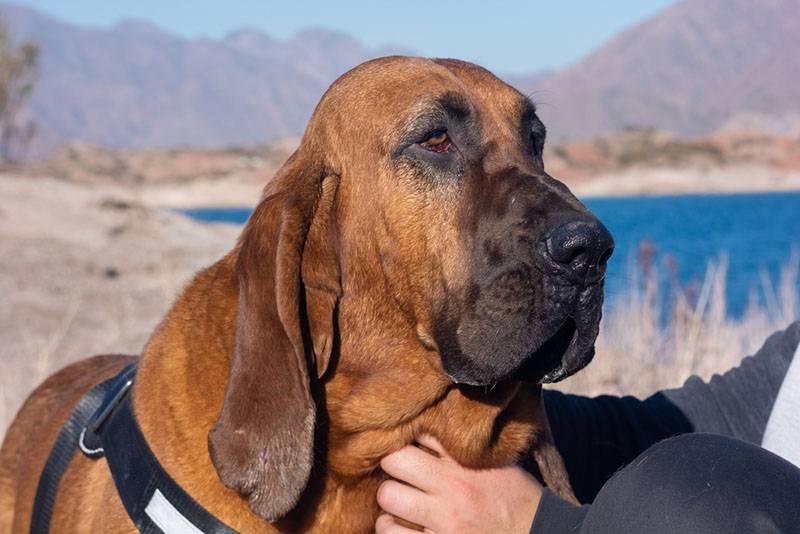
Bloodhound Nutrition Tips
To better understand how to properly feed your dog, you need to remember how his ancestors ate. As you know, wolves ate exclusively protein foods, that is, meat. That is why the basis of the diet of a four-legged friend of man is precisely protein. Carbohydrates are also needed, but they should not be so much. Fats are no less important for health, but their daily intake is negligible – about 7 ml.
Choose one of the possible feeding options for the animal. Food is either self-cooked or purchased from industrial rations. With any type of feeding, a diet for a pet is made by a specialist – a nutritionist. He will select a diet in accordance with the age of the dog, its activity, health status.The easiest option is to purchase ready-made food.
It can be dry or wet (canned). When buying, be sure to pay attention to the composition. In it, meat should be in the first place, and not cereals or starch. Do not give preference to cheap economy class rations. In the process of their production, products of not the highest quality are used. It is better to choose premium and super-premium class.
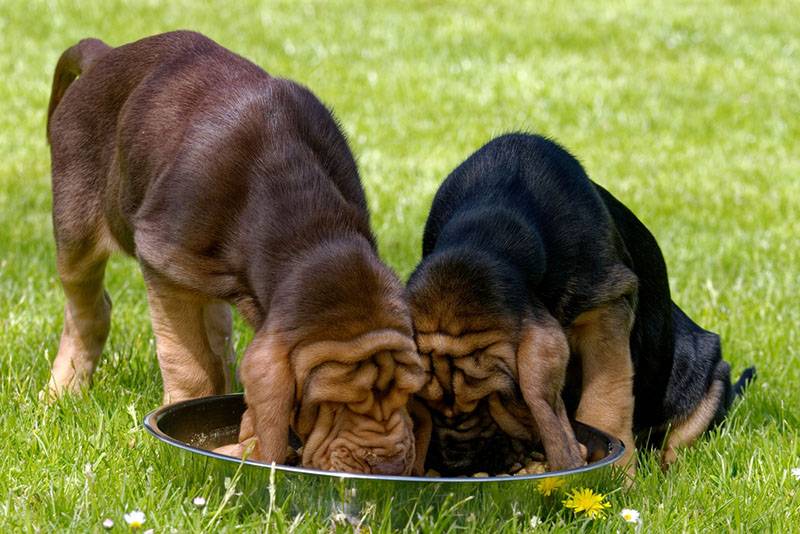
Food should be stored correctly: dry rations should be sealed tightly so that air does not get into them, canned food is placed in the refrigerator.
Natural products are a rather complicated option. Not only will you have to buy a large amount of food, you will have to cook it yourself. In addition, you will need to calculate the weight and calorie content of each serving. For people who are not experienced in such matters, this can be very difficult.
Don’t forget about your diet. The dog should eat by the clock. Every day the dog takes food the same number of times, at a certain time. Snacking is not considered the norm, it is better not to have any at all. Food from the table is undesirable. You should also remember that there are a number of foods that are extremely harmful to dogs: grapes, avocados, raw meat and fish, onions and garlic, etc.
If the dog consumes in excess of the prescribed norm, he will soon begin to gain excess weight.
Immediately after the end of the meal, the bowl is removed from view. Leave only a container of water.
The number of meals per day is highly individual. The recommended number of meals for large dogs such as Bloodhounds is 2 per day. If you feed your pet only once, then a stomach torsion may occur. It is advisable to eat not before walking, but after it.
Vitamin and mineral supplements should be purchased for dogs that are on a natural diet or for those that eat non-complete foods (minerals and vitamins are not included in their composition). Animals consuming a complete diet do not need a separate intake of mineral-vitamin complexes. Only a doctor can prescribe vitamins.
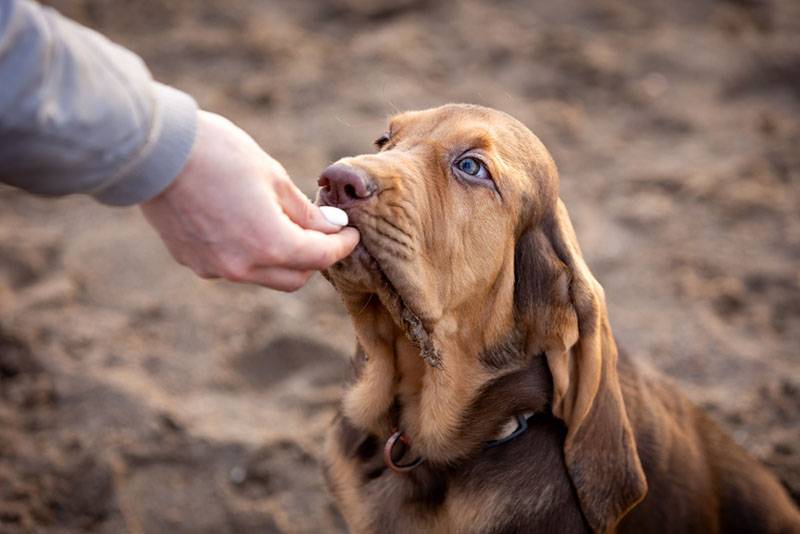
Health and typical diseases of Bloodhounds
Various gastrointestinal disorders are considered characteristic types of diseases for Bloodhound dogs. For example, torsion of the stomach.
Often they are also diagnosed with diseases of the eyes, ears and skin. Owners are advised to regularly inspect the pet for all kinds of inflammation and redness. If any problems are found, it is advisable to immediately contact the clinic to find out the cause of this condition.
In addition, these animals should not be too long in the sun, they can get heatstroke.
Their average life expectancy is relatively short. According to research conducted by the British Kennel Club, it was about 7 years.
Photo of Bloodhounds
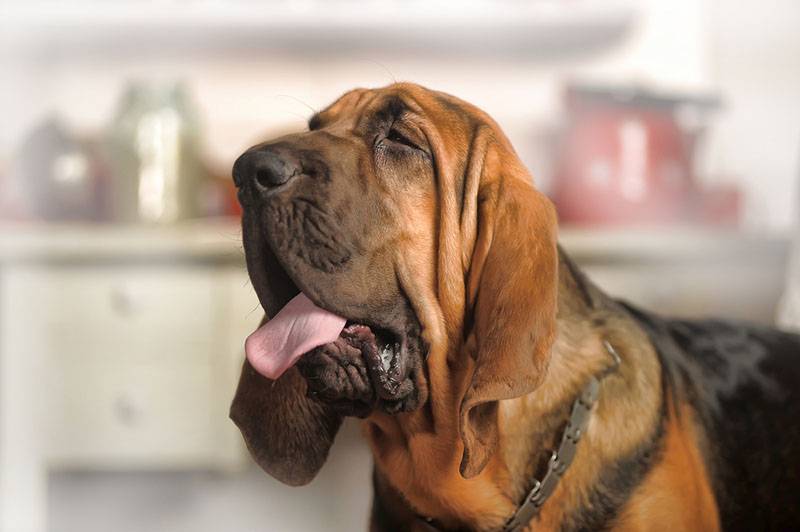
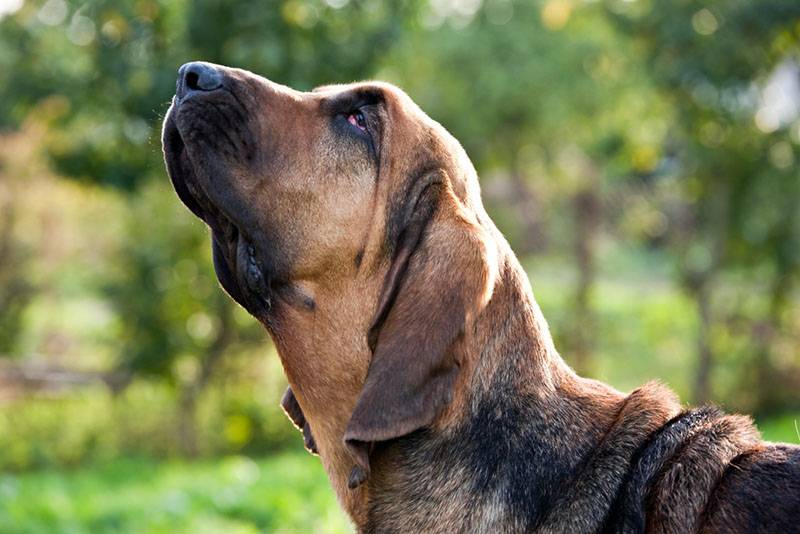
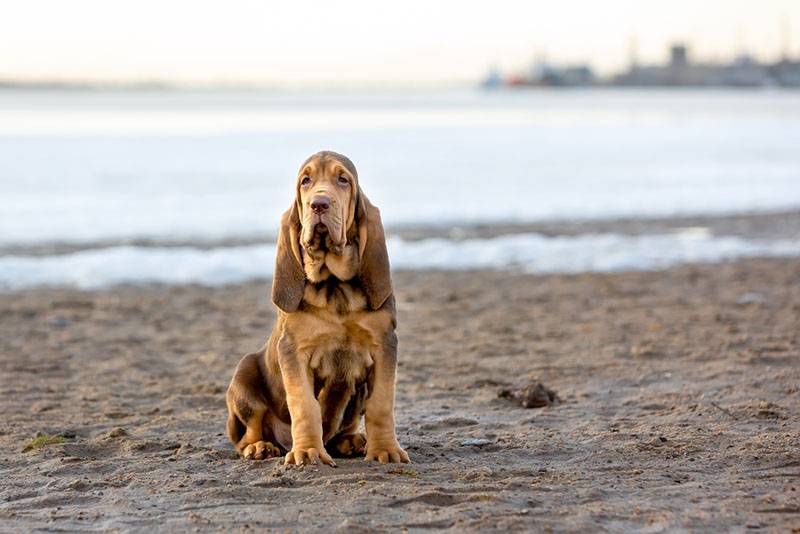
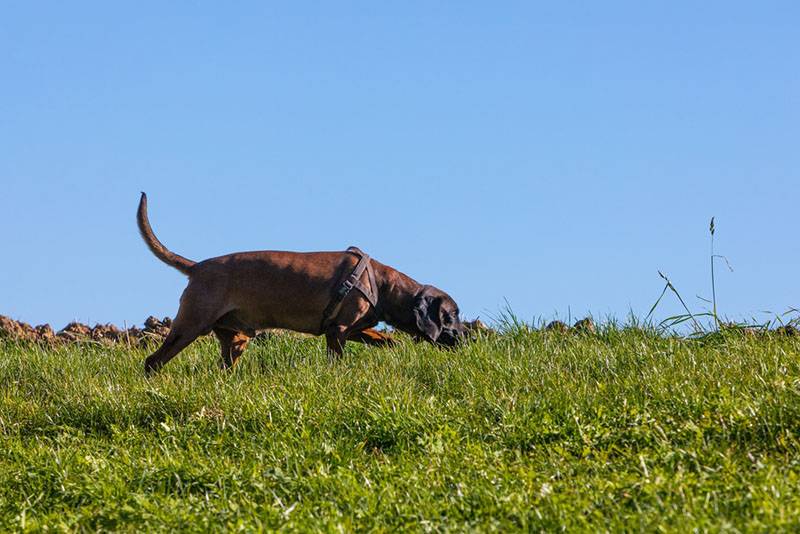

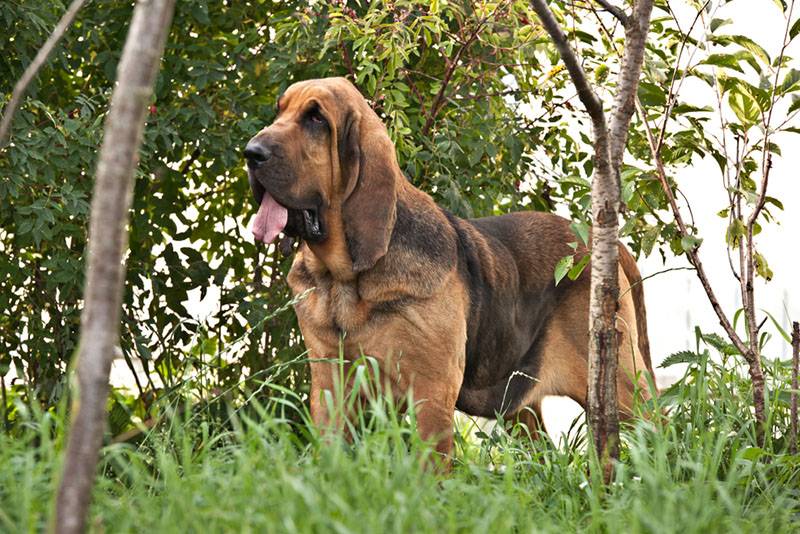
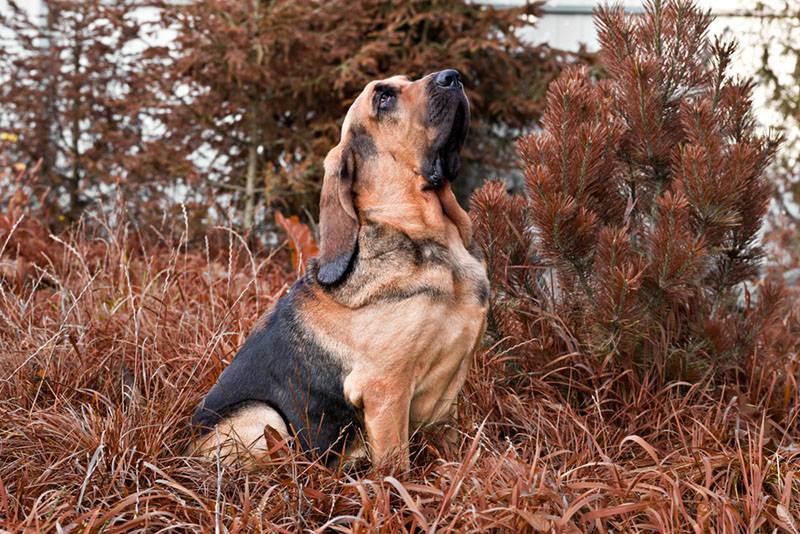
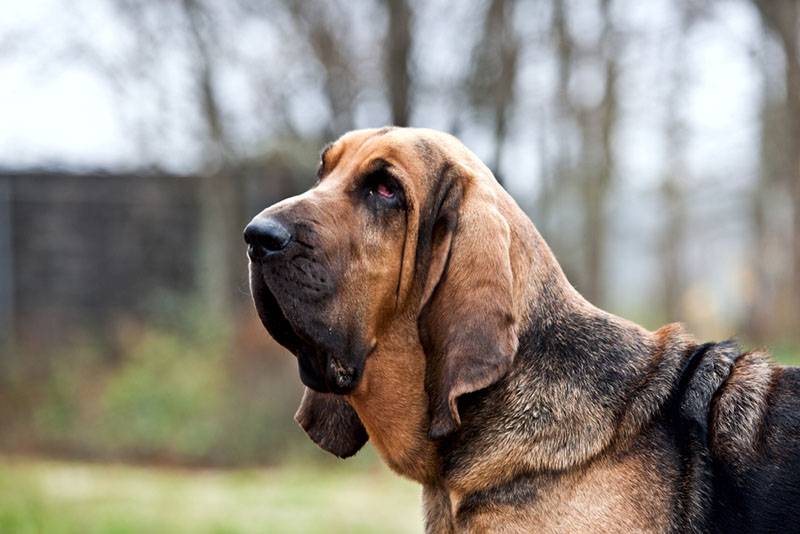
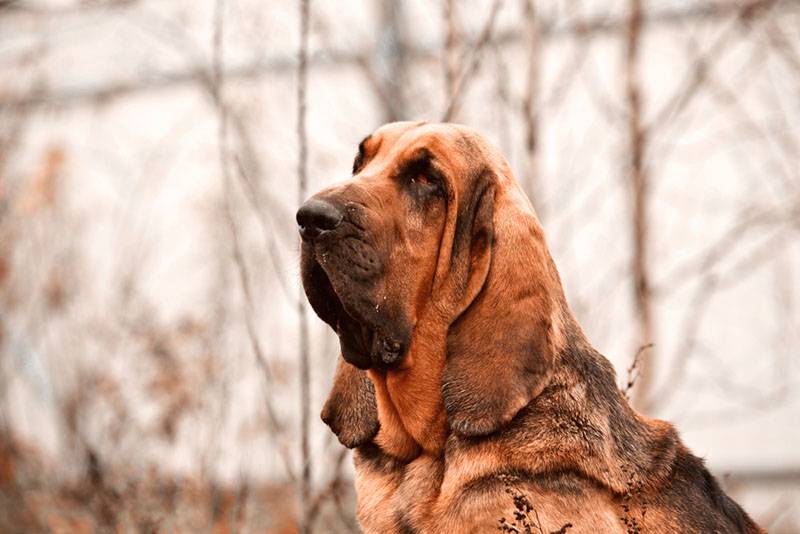
Who is this breed for?
Bloodhounds are perfect for dog breeders who are planning to get a pet:
- Calm and balanced;
- Having an excellent scent;
- Loving outdoor activities;
- With a coat that requires minimal care.
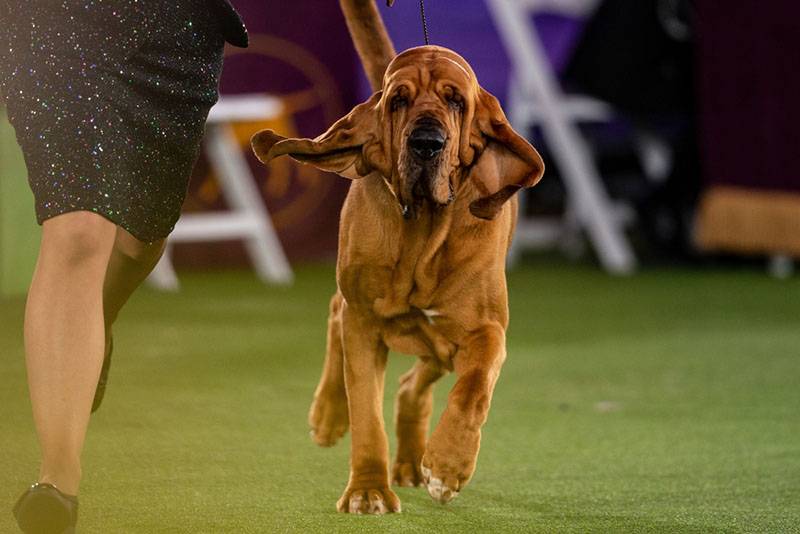
This breed is not recommended for people who are not ready for:
- Acquire a dog that matures for about two years;
- To a long and loud bark;
- To endure the stubbornness of a four-legged friend;
- Buy a pet that is not able to protect a house or apartment.
Bloodhounds require constant physical activity. Otherwise, they will quickly lose their shape. They need an active and athletic owner who does not like to stay at home. Ideally, this should be a hunter who prefers to hunt animals with hound breeds.
The owner can be either a single person or a family. Animals are very fond of children.
Famous Bloodhound dogs
In America, Bloodhounds were actively used as search dogs. The most famous dog to serve in the Kentucky State Police was Nick Carter, who arrested more than 650 intruders. This dog was born in 1900. Captain Mullikin was its owner.
How to choose the right puppy
Before choosing this particular breed, you need to think very carefully about your decision. The Bloodhound is a pet that will require constant exercise, mental stimulation, and trips to the woods for walks. In addition, due to the animal’s tendency to stubbornness, its owner must be distinguished by firmness of character, perseverance and tolerance. To learn more about Bloodhounds, visit exhibitions, talk to dog breeders, cynologists, read literature about the breed, study the standard.
If, nevertheless, you have decided that the breed is ideal for you, start looking for a breeder. The best option is to contact a professional nursery that has been operating for more than a year. The specialists of such an organization, as a rule, are experienced people. They will help you not only choose the right puppy, but also give advice on its upbringing and maintenance.
Bloodhounds are a breed that is currently not considered super popular. That is why there are not so many nurseries in our country.
You can also contact a private breeder, after making sure that this person works honestly and in good faith. Often, experienced hunters are involved in the sale of dogs, who have a great chance of acquiring a dog with excellent performance. For a dog to become an excellent hunter, its parents must be workers.
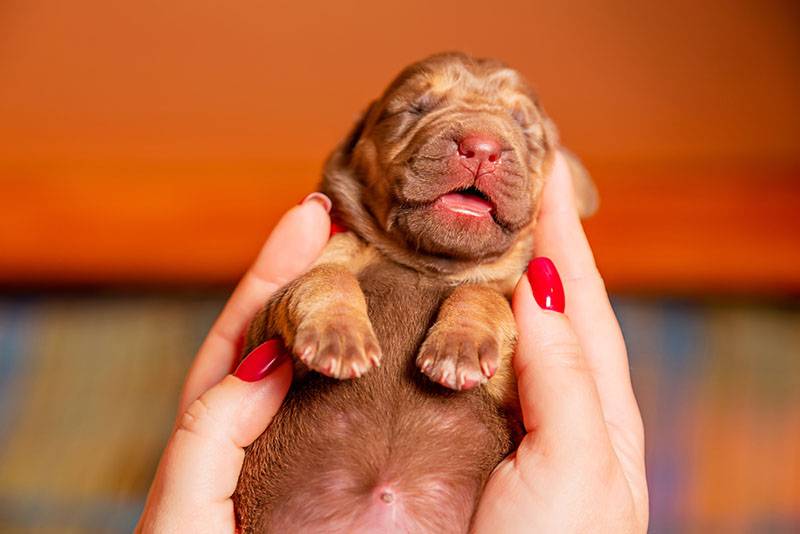
Be sure to visit the room in which the kids and their mother are kept. Examine it. It cannot be dirty and dusty. The puppies themselves should also look neat. Their eyes are always clear, their ears are clean, there are no pimples or redness on the skin.
The belly of a healthy puppy is soft, not firm. A tight tummy is most often an indication of its infestation with parasites. The paws should be straight, the tail – without creases, even. Already in puppyhood, skin folds are present on the body (especially on the muzzle) of the animal. The ears are rather long and soft.
It is not uncommon for Bloodhound puppies to look plump. This should not scare the buyer, as it is considered the norm. As the dog grows, it will become fit and slender, as required by the breed standard.
In kennels, each buyer is provided with a package of documents: a veterinary passport and a puppy’s metric. They contain all the necessary information about the dog. The majority of kennels mark their wards with a brand – a unique code of letters and numbers that helps to identify the dog, if necessary. It is located on the ear or in the groin of the animal. Often a chip is implanted instead of a brand.
Pay attention to the behavior of the breeder. He can’t act distant, refuse to answer your questions. Breeders who care about their puppies are always ready to make contact. It is not uncommon for prospective dog breeders to ask themselves questions about their living space, experience in keeping pets, and so on.
Photos of bloodhound puppies
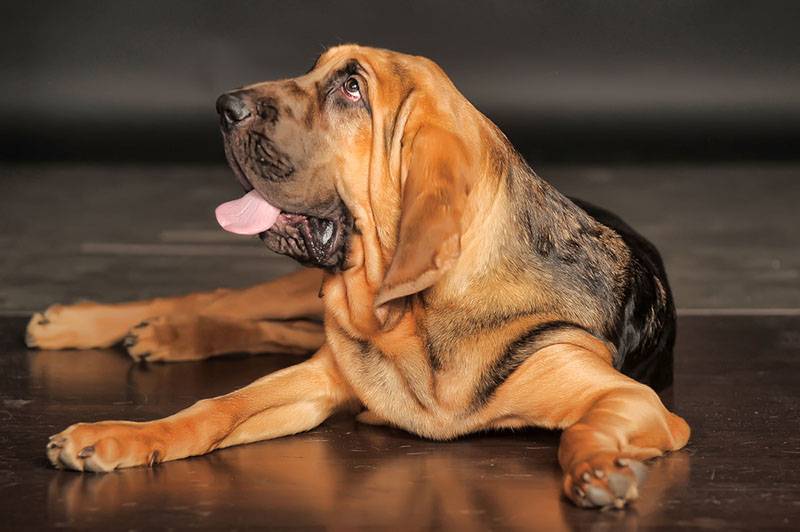
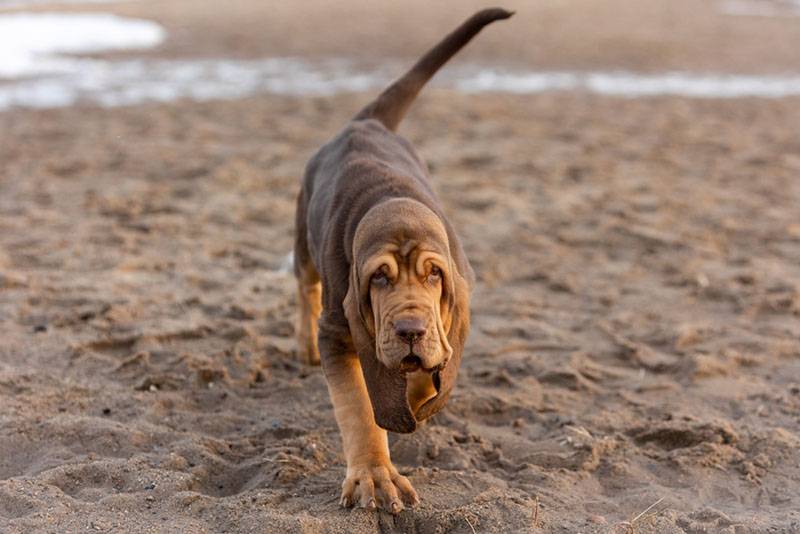
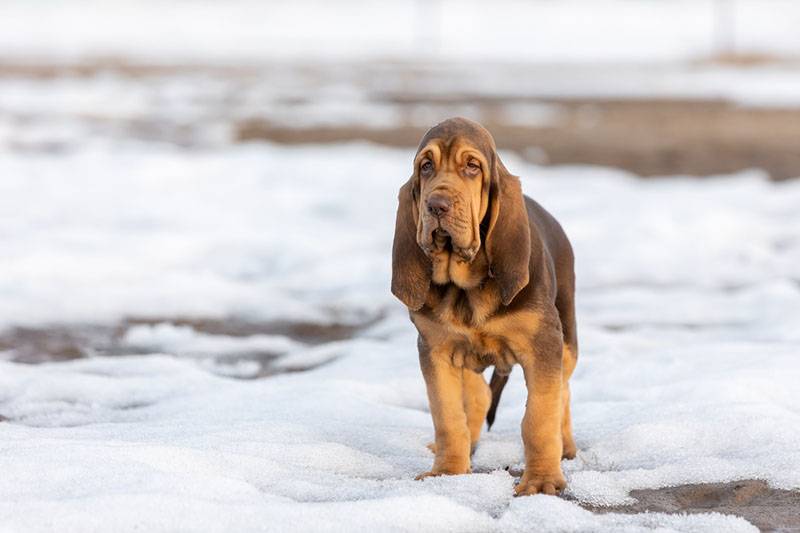
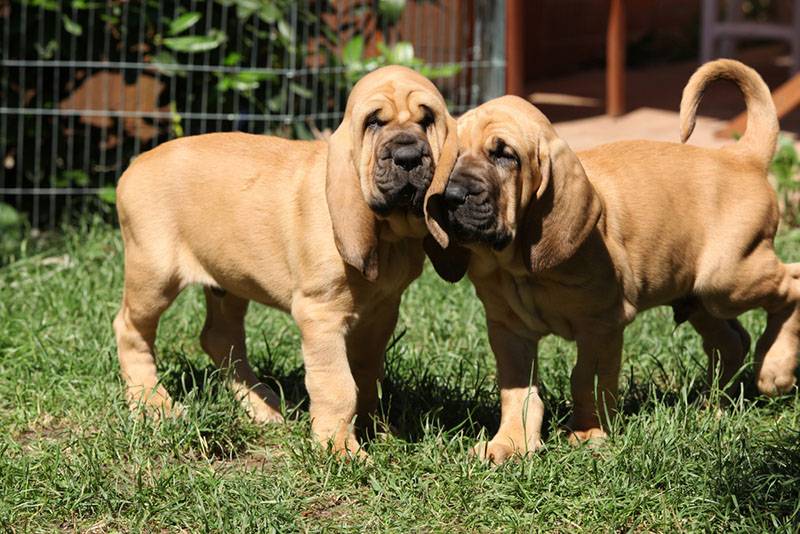
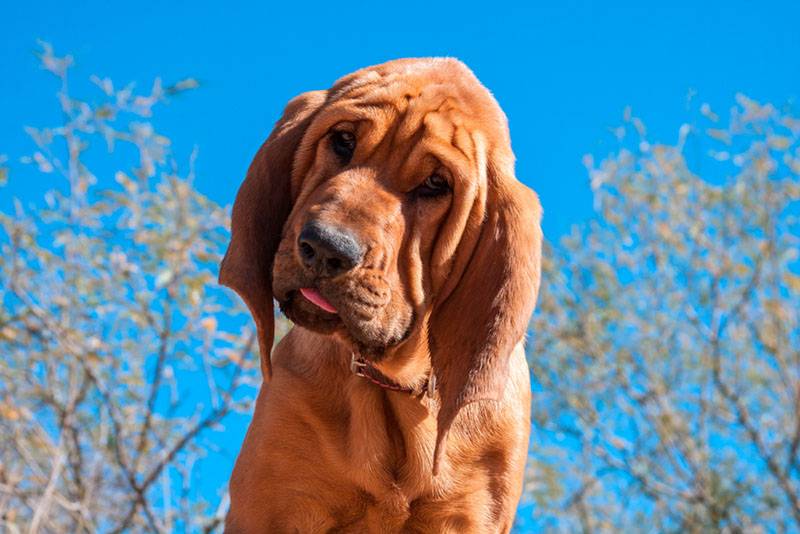
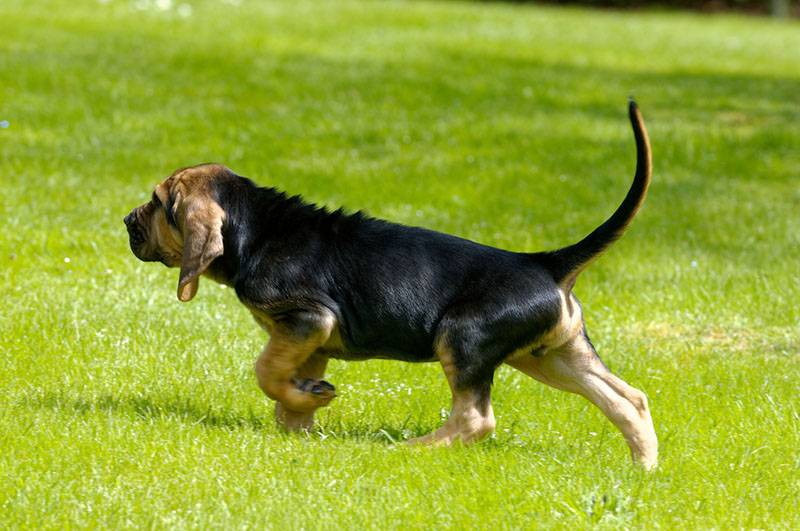
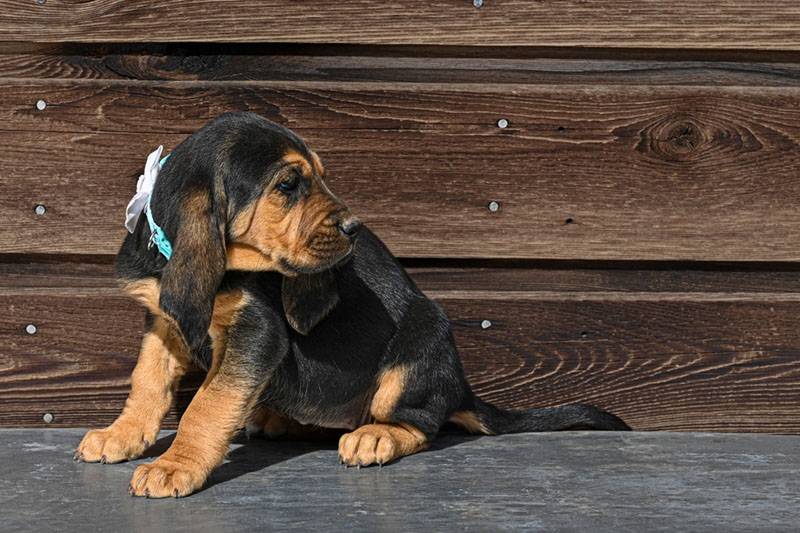
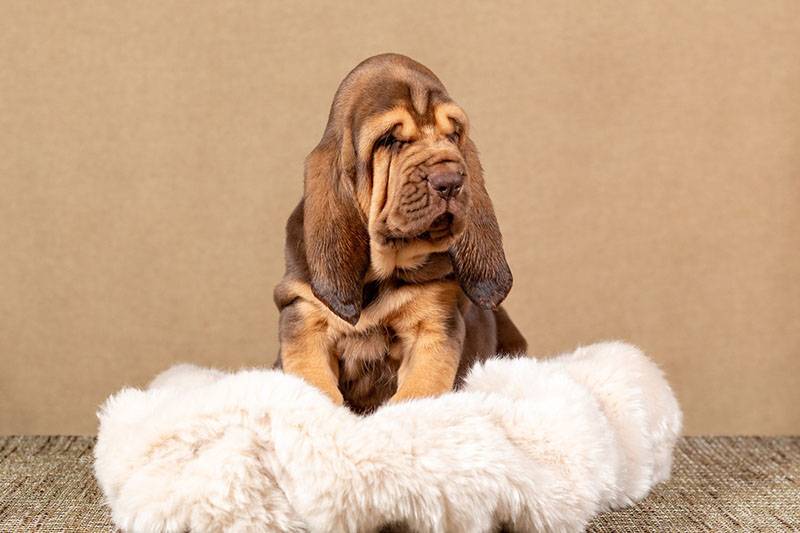
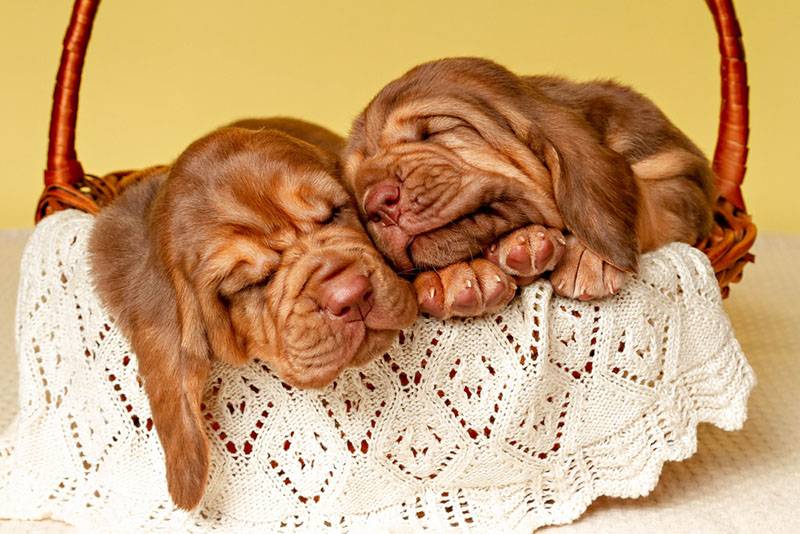
Owner experience
We have carefully studied the reviews and comments of the owners of this breed. The owners of the Bloodhounds are sure that their pets:
- Smart and quick-witted;
- They are the owners of the saddest and most penetrating look;
- Sometimes they tend to be stubborn;
- Excellent working dogs;
- Very large and powerful.
The owners claim that their pets are excellent trackers. When the dog went for a walk, he is immediately ready to bury his nose in the ground and follow the trail. Therefore, you need to let the dog off the leash only in fenced areas where he cannot run far from you.
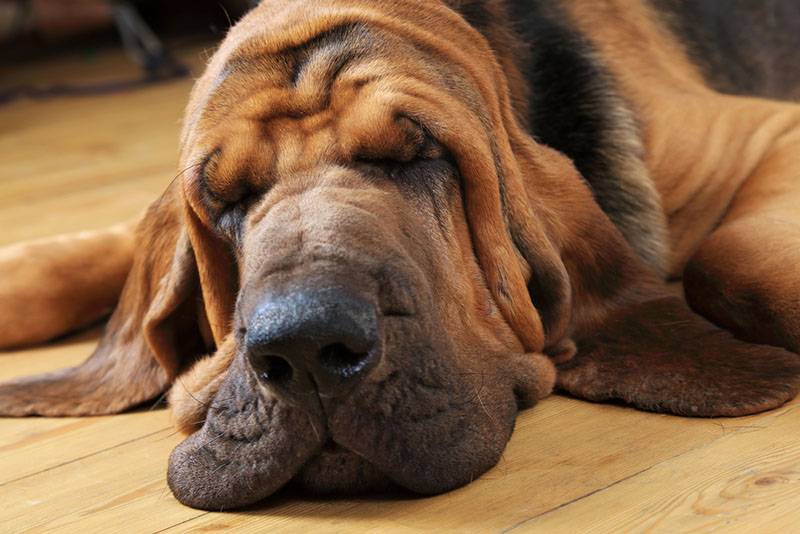
Dog breeders are advised to teach the Bloodhound to walk alongside, rather than pull the owner, while walking. Otherwise, this large dog will pull the leash so hard that it can easily injure a person’s hand.
The majority of owners are sure that such a pet should not be kept in a city apartment. It is better if the Bloodhound lives in a country house.
Regular walks are essential. They must be active and fairly long. The dog needs to throw out his energy. If there is no surge of energy, the Bloodhound begins to smash the apartment. And given the size of the animal, “losses” can be catastrophic.
These animals love to be in nature. If the Bloodhounds behave calmly at home, then in the forest they turn into real working dogs. They are active, love to dig the ground, all the time trying to find a trace of any beast.
Bloodhound prices
We contacted some Bloodhound breeders and found out how much bloodhound puppies cost.
In nurseries, the price tag will always be higher – from 800 to 1100$. The price depends on the sex of the dog, the title of his parents and the popularity of the kennel.
From a private breeder, you can buy a healthy Bloodhound puppy worth 150-500 $.
Bloodhound – Video



